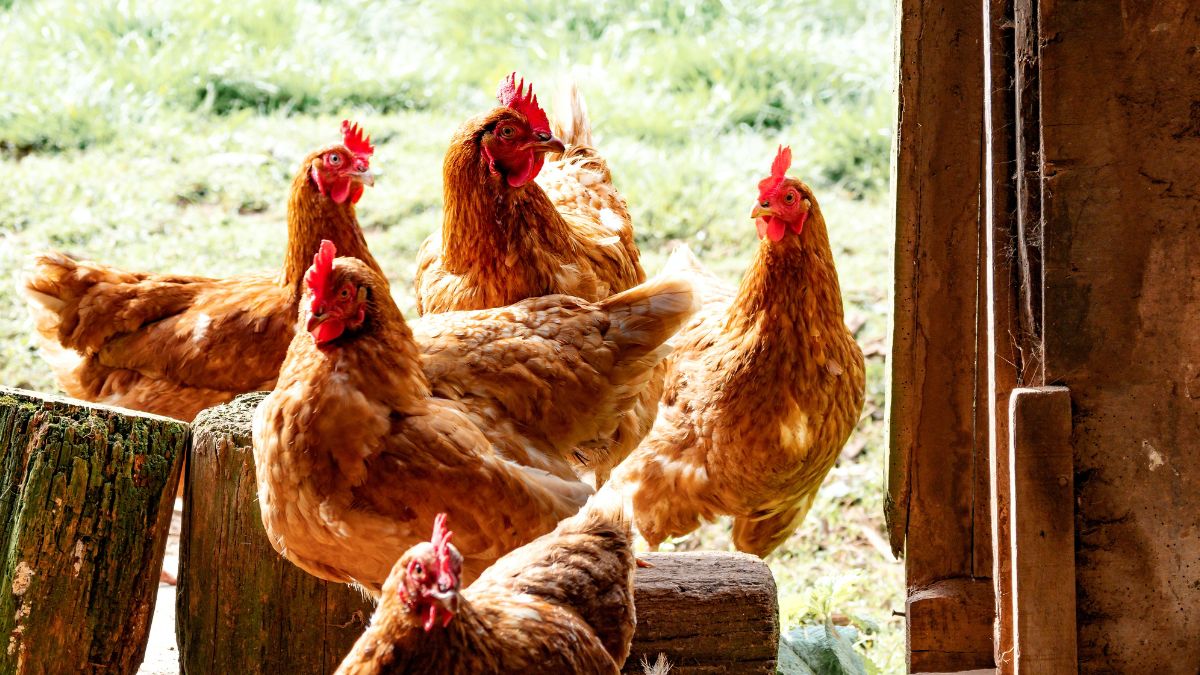Can Chicken Eat Potatoes? Is It Safe for Them?

In the realm of backyard farming, providing the right diet to your flock is paramount. Among the many table scraps and farm produce that one might consider feeding, potatoes often pop up as a query. Can chickens safely nibble on this popular tuber? Let’s dive into the details to unravel the truth about chickens and potatoes.
Nutritional Value of Potatoes for Chickens
Potatoes, being a staple in human diets around the world, have a robust nutritional profile that might be considered beneficial for chickens as well. But, it’s essential to understand these nutrients from a chicken’s perspective.
- Starch and Carbohydrates: Potatoes are a rich source of carbohydrates, mainly in the form of starch. While grains are the primary carbohydrate source in a chicken’s diet, potatoes can act as a supplemental energy source.
- Vitamins: Potatoes contain several vitamins like vitamin C, vitamin B6, and niacin, which can contribute to the overall health of a chicken. However, these vitamins are present in amounts that may be considered trace when compared to the dietary needs of chickens.
- Minerals: These tubers are a source of essential minerals like potassium, magnesium, and iron. These minerals play a role in various physiological functions, including nerve function, muscle contraction, and oxygen transportation.
- Dietary Fiber: Potatoes contain dietary fiber, which can aid digestion. However, it’s worth noting that chickens have a shorter digestive tract than mammals, so they might not benefit from fibers the same way humans do.
- Proteins: Potatoes have a modest protein content, but they can’t compare to the protein-rich feeds like worms, insects, or formulated chicken feed. Chickens require a significant amount of protein for egg production, feather growth, and general body maintenance.
- Water Content: Cooked potatoes have high water content, which can help hydrate chickens, especially during warmer months.
While potatoes can offer some nutritional value, they shouldn’t form the primary food source for chickens. They’re best used as an occasional treat or supplement, ensuring that the flock continues to get a balanced diet that meets all their essential needs. Also, it’s crucial to take note of the preparation method, as raw or green potatoes can pose health risks, which will be covered in subsequent sections.
Potential Risks of Feeding Raw Potatoes
Feeding chickens raw potatoes might seem like a natural choice, given the simplicity involved. However, it’s essential to understand the potential risks associated with this practice.
Solanine Toxicity: Potatoes, especially when they turn green or sprout, contain solanine – a natural toxin. This substance can be harmful to chickens when consumed in large amounts. Signs of solanine poisoning include weakness, labored breathing, paralysis, and, in severe cases, death.
Hard to Digest: Raw potatoes are starchy and can be tough for chickens to digest. Consuming raw potatoes can lead to digestive issues and potential blockages, especially if large chunks are ingested.
Choking Hazard: Depending on the size and how they are presented, raw potato pieces can pose a choking risk, especially to younger birds.
Reduced Nutrient Absorption: Certain compounds in raw potatoes can reduce the absorption of essential nutrients in the gut, potentially leading to deficiencies in the long run.
Potential for Mold Growth: If raw potatoes, especially those with cuts or bruises, are left out for long periods, they can develop mold, which is harmful when ingested.
Inadequate Nutritional Replacement: Relying heavily on potatoes as a significant part of a chicken’s diet can lead to nutritional imbalances. Raw potatoes don’t provide the necessary range of nutrients that chickens require for optimal growth, egg production, and health.
In light of these potential risks, if one chooses to feed potatoes to their chickens, it’s advisable to offer them cooked and in moderation. Cooking helps neutralize solanine and breaks down the starches, making them easier for chickens to digest and derive benefits from.
The Green Parts: A Word of Caution
The green parts of a potato, often seen on the skin or sprouting eyes, are more than just a sign of an aging tuber. They indicate the presence of solanine, a natural toxin produced in potatoes, typically as a defense mechanism against pests. Solanine isn’t just harmful to pests; it can also be toxic to chickens when consumed in significant amounts.
While a small nibble on a green potato might not immediately harm a chicken, consistent or large-scale consumption can lead to solanine poisoning. Symptoms in chickens can range from gastrointestinal distress and labored breathing to more severe manifestations like paralysis or even death.
It’s not just the visibly green parts that contain solanine. If a potato has been exposed to light for an extended period, causing it to turn green, solanine might be distributed throughout the tuber, even if it’s not visibly green in some sections.
To ensure the safety of your flock, it’s always best to avoid feeding any part of a potato that’s turned green. If you choose to offer potatoes, make sure they are fresh, free from green patches, and ideally cooked to neutralize any residual toxins and make them more digestible for your birds.
Cooking Potatoes for Chickens: Is it Necessary?
Cooking potatoes for chickens is not just a matter of preference but also one of safety and digestibility. While it’s not mandatory to cook potatoes before offering them to your flock, doing so can significantly mitigate some potential risks associated with raw potatoes.
Firstly, cooking helps to neutralize solanine, the natural toxin found in green parts of potatoes. Even if the potato isn’t visibly green, there’s still a possibility of minor solanine content, and cooking can help reduce this risk.
Beyond safety concerns, cooking potatoes also aids in their digestibility for chickens. The heat breaks down the starches in the potatoes, making them easier for chickens to digest. Raw potatoes can be tough on a chicken’s digestive system and might not be processed as efficiently, potentially leading to digestive discomfort or blockages.
Moreover, cooked potatoes, especially when mashed, can be a delightful treat for chickens. Their softer texture and warmth can be appealing, and chickens are likely to enjoy them more compared to the raw version.
While it might be tempting to toss raw potato scraps to your flock for convenience, cooking them ensures they are safer and more digestible. The extra effort involved in preparing cooked potatoes for your chickens is a small price to pay for the peace of mind and the health benefits they offer.
Serving Suggestions: How to Offer Potatoes to Chickens
When offering potatoes to chickens, it’s not just about ensuring they’re safe to eat, but also about presenting them in a manner that’s enticing and appropriate for your flock. Here are some serving suggestions for providing potatoes to chickens:
Mashed: One of the simplest and most preferred ways is to serve potatoes mashed. After boiling the potatoes thoroughly, mash them without any additives like salt, butter, or milk. The soft texture is easy for chickens to peck at, and they often find it delightful.
Small Chunks or Dice: If you don’t wish to mash them, ensure you chop the cooked potatoes into small, bite-sized chunks. This reduces the risk of choking and ensures younger birds can also enjoy them.
Mix with Other Foods: Combine cooked potatoes with other safe veggies or grains to offer a diverse and nutrient-rich treat. This could include peas, corn, or even a bit of rice.
Avoid Seasonings: When preparing potatoes for chickens, keep them plain. Avoid adding salt, butter, seasonings, or any other additives that are typical in human dishes. These can be harmful to chickens or add unnecessary salts and fats to their diet.
Serve in Moderation: Remember, potatoes should be a treat and not a regular staple in their diet. Offer them occasionally and ensure that your flock still consumes their regular feed, which provides the essential nutrients they need.
Monitor Freshness: Only offer fresh, well-cooked potatoes. Leftovers that have been sitting out for too long might develop mold or other harmful microbes. If you’re unsure about the freshness, it’s better to err on the side of caution and discard them.
Use Shallow Dishes: When serving potatoes, especially in mashed form, use shallow dishes. This makes it easier for chickens to access and reduces the chances of them stepping into the food, which can create a mess.
By following these serving suggestions, you can ensure that your flock enjoys their potato treats safely and healthily, all while relishing the change in their usual diet.
Alternative Foods: Healthier Options for Your Flock
When looking for treats and dietary supplements for your chickens, it’s always a good idea to explore various options that are both nutritious and safe. While potatoes can be a suitable occasional treat, there are many alternative foods that can be healthier choices for your flock:
- Leafy Greens: Vegetables like kale, spinach, and lettuce are excellent for chickens. They are packed with essential nutrients and can be scattered around the coop for the chickens to peck at.
- Fruits: Berries, melons, and apples (without seeds) are great fruity treats. They are refreshing, especially during warmer months, and can provide a range of vitamins.
- Grains: Quinoa, rice, and oats are wholesome grains that can be offered cooked. They’re rich in energy-providing carbohydrates.
- Protein-rich foods: Insects like mealworms, earthworms, or black soldier fly larvae are fantastic protein sources. They not only supplement the diet but also mimic the natural foraging behavior of chickens.
- Grit: While not a food, offering crushed oyster shells or coarse sand can aid in digestion, as it helps chickens grind down grains in their gizzard. Plus, oyster shells are a good calcium source, which is crucial for egg-laying hens.
- Sprouted Seeds: Seeds like alfalfa or sunflower can be sprouted and offered to chickens. Sprouting increases the nutritional value of seeds, making them a powerhouse of vitamins and minerals.
- Herbs: Herbs such as parsley, mint, oregano, and basil are not only nutritious but also have various health benefits. For instance, garlic and oregano are known to have natural antimicrobial properties.
- Garden Peels and Scraps: Don’t discard the tops of carrots, beet greens, or the ends of cucumbers. These are all great for chickens and offer variety to their diet.
- Yogurt or Cottage Cheese: In small amounts, plain yogurt or cottage cheese can be a source of protein and probiotics. However, ensure it’s unsweetened and unflavored.
- Fermented Feed: Fermenting your chicken feed can boost its nutritional content and provide probiotics, aiding in digestion and overall gut health.
Incorporating a mix of these alternative foods can keep your chickens’ diet varied and nutritionally balanced. However, always remember that treats and supplements should make up only a small portion of the overall diet, with the primary nutrition coming from a good-quality chicken feed.

